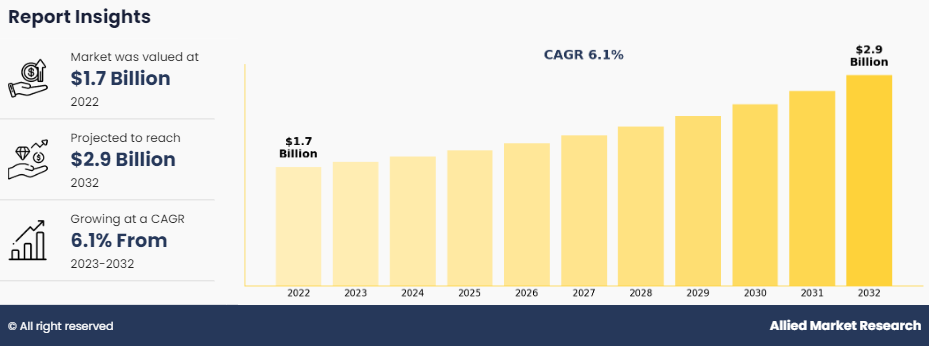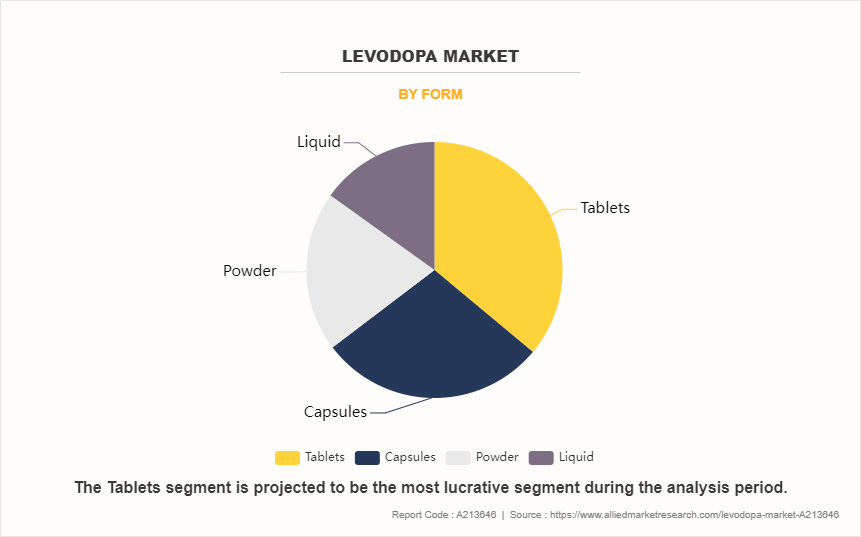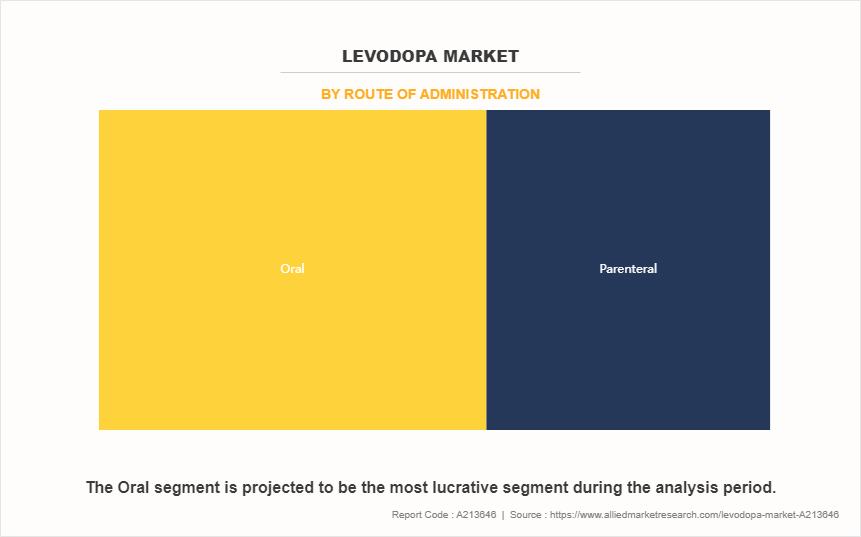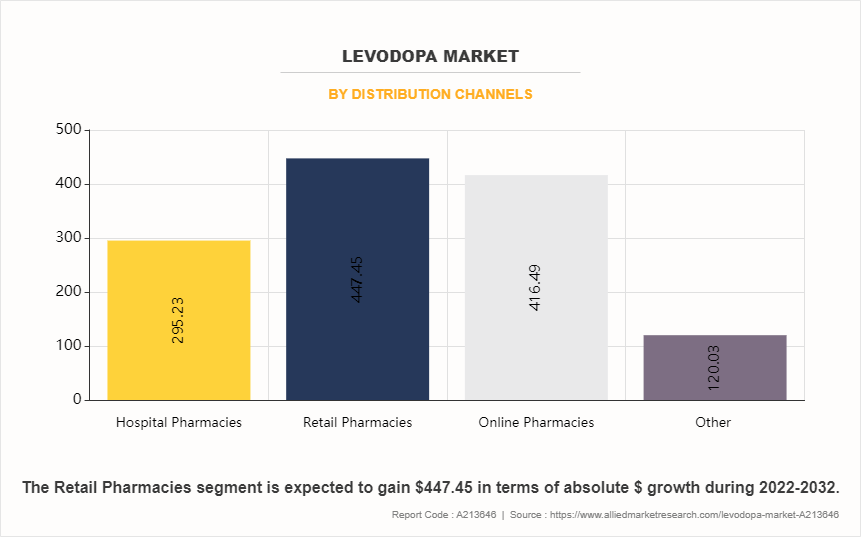Levodopa Market Research, 2032
The global levodopa market size was valued at $1.7 billion in 2022, and is projected to reach $2.9 billion by 2032, growing at a CAGR of 6.1% from 2023 to 2032. Increase in aging population has driven the demand for effective treatments for Parkinson's disease, including levodopa, as a primary treatment option.

Levodopa, also known as L-DOPA, is a medication primarily used to manage symptoms of Parkinson's disease. It is a precursor to dopamine, a neurotransmitter in the brain essential for movement control. Levodopa crosses the blood-brain barrier and is converted into dopamine, replenishing deficient levels in Parkinson's patients. Moreover, by increasing dopamine levels, levodopa helps alleviate motor symptoms such as tremors, stiffness, and bradykinesia. However, long-term use can lead to complications such as dyskinesias. It is often combined with other medications such as carbidopa to enhance its effectiveness and reduce side effects.
Market Dynamics
Rising Prevalence of Parkinson's Disease to Drive the Growth of the Levodopa Market
The levodopa industry has been witnessing significant growth, owing to rise in prevalence of Parkinson's disease, a progressive neurological disorder characterized by the loss of dopamine-producing neurons in the brain. This demographic trend is primarily attributed to factors such as longer life expectancy and changing lifestyle patterns. In addition, surge in prevalence of Parkinson's disease underscores the urgent need for therapeutic interventions to alleviate symptoms and improve the quality of life for affected individuals. Levodopa, being a precursor to dopamine, plays a crucial role in replenishing dopamine levels in the brain, thereby mitigating motor symptoms such as tremors, rigidity, and bradykinesia associated with Parkinson's disease. Moreover, rise in demand for Levodopa is closely linked to surge in Parkinson's disease patients globally, highlighting its pivotal role in disease management and driving the growth of the levodopa market.
Safety Concerns and Side Effects of Levodopa to Restrain the Market Growth
However, rise in safety concerns and side effects are the key factors restraining the growth of the levodopa market. Furthermore, patients undergoing levodopa therapy frequently experience adverse effects such as nausea, vomiting, orthostatic hypotension, and psychiatric disturbances, which can reduce treatment tolerance and adherence. In addition, long-term safety apprehensions, including potential neurotoxic effects and the risk of disease progression, deter widespread utilization of levodopa. These concerns not only impact patient compliance but also raise hesitancy among healthcare providers to prescribe levodopa as a primary treatment option for Parkinson's disease, posing a substantial restraint on the growth of the levodopa market.
Technological Advancements in Drug Delivery to Drive Excellent Opportunities
On the contrary, technological advancements in drug delivery signify a significant opportunity for the levodopa market, offering the potential to revolutionize treatment strategies for Parkinson's disease. By leveraging innovative formulations and alternative routes of administration, such as extended-release formulations or transdermal patches, drug developers can address key challenges associated with levodopa therapy. Moreover, extended-release formulations provide a sustained release of levodopa over an extended period, maintaining stable plasma concentrations and minimizing fluctuations in drug levels. Furthermore, this approach not only improves treatment adherence by reducing the frequency of dosing but also helps mitigate motor fluctuations and dyskinesias commonly associated with traditional immediate-release formulations.
In addition, alternative routes of administration, such as transdermal patches or inhalation-based delivery systems, offer non-invasive and convenient options for patients, enhancing treatment adherence and patient satisfaction. Moreover, advanced drug delivery technologies enable targeted delivery of levodopa to specific brain regions, optimizing therapeutic efficacy while minimizing systemic side effects. Furthermore, by overcoming the blood-brain barrier efficiently, these technologies hold the potential to enhance levodopa's central nervous system penetration, thereby improving symptom control and patient outcomes. In addition, ongoing advancements in drug delivery technologies offer lucrative opportunities to enhance the efficacy, safety, and patient experience associated with levodopa therapy, ultimately driving the market potential and improving the standard of care for individuals with Parkinson's disease.
Competitive Landscape
The key players operating in the levodopa market include Novartis AG, Merck & Co. Inc., Eli Lilly & Company, Bristol-Myers Squibb Co., Teva Pharmaceutical Industries Ltd., Impax Laboratories Inc., Pfizer Inc., UCB SA, Sun Pharmaceutical Industries Ltd., and Mylan NV. Moreover, investment and agreement are common strategies followed by major market players. For instance, In March 2018, Acorda Therapeutics, Inc. filed a Marketing Authorization Application (MAA) with the European Medicines Agency (EMA) for INBRIJA. This is an investigational inhaled levodopa treatment designed to address symptoms of OFF periods in individuals with Parkinson's disease who are on a Carbidopa/Levodopa regimen. OFF periods signify the recurrence of symptoms such as rigidity and tremors after prolonged use of levodopa.
Segments Overview
The levodopa market is segmented on the basis of form, route of administration, distribution channels, and region. By form, the market is segmented into tablets, capsules, powder, and liquid. By route of administration, the market is bifurcated into oral and parenteral. By distribution channels, the market is classified into hospital pharmacies, retail pharmacies, online pharmacies, and other. By region, the market is analyzed across North America, Europe, Asia-Pacific, and LAMEA.
By Form

The tablets segment dominated the market in 2022. The tablet form of levodopa serves as a driving factor in the Parkinson's disease treatment market due to its convenience, affordability, and widespread acceptance. Tablets offer a simple and familiar mode of administration, facilitating patient adherence to treatment routines. Furthermore, the availability of various tablet strengths allows for flexible dosing tailored to individual patient needs, optimizing therapeutic outcomes. In addition, tablets are relatively cost-effective compared to alternative formulations, making levodopa accessible to a broader patient population. As a result, the convenience and practicality of levodopa tablets contribute significantly to the medication's popularity and market demand. These are predicted to be the major factors affecting the levodopa market size during the forecast period.
By Route of Administration
By route of administration, the oral segment dominated the global levodopa market share in 2022. The oral route of administration for levodopa remains a dominant segment in the market, driven by its convenience, familiarity, and widespread acceptance among patients and healthcare providers. With oral formulations readily available in various dosages, patients can easily adhere to treatment regimens. Moreover, advancements in extended-release formulations enhance efficacy and minimize motor fluctuations. Furthermore, the oral route's accessibility and versatility make it a preferred choice, particularly in early to mid-stage Parkinson's disease. As a result, the oral segment continues to thrive, catering to patients' diverse needs and contributing significantly to the levodopa industry growth.

By Distribution Channels
The retail pharmacies segment dominated the global levodopa market share in 2022. The retail pharmacies distribution channel for levodopa is driven by several factors. One key factor is the widespread accessibility of retail pharmacies, providing convenient access to levodopa for patients managing Parkinson's disease. In addition, the presence of trained pharmacists in retail settings offers personalized guidance and support to patients, enhancing treatment adherence and satisfaction. Moreover, retail pharmacies often stock a variety of medications, including levodopa, allowing patients to fulfill their prescriptions conveniently. Overall, the convenience, accessibility, and personalized support offered by retail pharmacies play a crucial role in driving the distribution of levodopa through this channel.

By Region
North America dominated the global levodopa market in 2022. In North America, the levodopa market is primarily driven by several key factors. The region's robust healthcare infrastructure and advanced medical research facilities foster innovation in Parkinson's disease management, including the development of novel levodopa formulations and treatment approaches. Furthermore, the high prevalence of Parkinson's disease in North America, coupled with an aging population, increases the demand for effective therapies such as levodopa. In addition, supportive healthcare policies and reimbursement frameworks ensure widespread access to levodopa among patients. Moreover, the presence of leading pharmaceutical companies and research institutions in the region contributes to market growth through continuous R&D efforts.

Key Benefits for Stakeholders
- This report provides a quantitative analysis of the market segments, current trends, estimations, and dynamics of the levodopa market analysis from 2022 to 2032 to identify the prevailing levodopa market opportunities.
- The market research is offered along with information related to key drivers, restraints, and opportunities.
- Porter's five forces analysis highlights the potency of buyers and suppliers to enable stakeholders make profit-oriented business decisions and strengthen their supplier-buyer network.
- In-depth analysis of the levodopa market segmentation assists to determine the prevailing market opportunities.
- Major countries in each region are mapped according to their revenue contribution to the global market.
- Market player positioning facilitates benchmarking and provides a clear understanding of the present position of the market players.
- The report includes the analysis of the regional as well as global levodopa market trends, key players, market segments, application areas, and market growth strategies.
Levodopa Market Report Highlights
| Aspects | Details |
| Market Size By 2032 | USD 2.9 billion |
| Growth Rate | CAGR of 6.1% |
| Forecast period | 2022 - 2032 |
| Report Pages | 300 |
| By Form |
|
| By Route of Administration |
|
| By Distribution Channels |
|
| By Region |
|
| Key Market Players | Pfizer Inc., Impax Laboratories Inc., Novartis AG, Merck and Co. Inc., Teva Pharmaceutical Industries Ltd., Sun Pharmaceutical Industries Ltd., Eli Lilly and Company, Bristol-Myers Squibb Co., UCB SA, Mylan Nv |
The driving factors in the levodopa market include rise in healthcare expenditure and increase in prevalence of Parkinson's disease. Opportunities lie in technological advancements, emerging markets, and ongoing research initiatives enhancing treatment efficacy and accessibility.
The major growth strategies adopted by levodopa market players are investment and agreement.
Asia-Pacific is projected to provide more business opportunities for the levodopa market in future.
Novartis AG, Merck & Co. Inc., Eli Lilly & Company, Bristol-Myers Squibb Co., Teva Pharmaceutical Industries Ltd., Impax Laboratories Inc., Pfizer Inc., UCB SA, Sun Pharmaceutical Industries Ltd., and Mylan NV are the major players active in the levodopa market.
Tablets segment of the form acquired the maximum share of the levodopa market in 2022.
Healthcare Providers are the major customers in the levodopa market.
The report provides an extensive qualitative and quantitative analysis of the current trends and future estimations of the levodopa market from 2022 to 2032 to determine the prevailing opportunities.
The key trends influencing the levodopa market include advancements in drug delivery systems, increase in focus on personalized medicine, and continued research into disease-modifying treatments for Parkinson's disease, shaping treatment efficacy and patient outcomes.
Loading Table Of Content...
Loading Research Methodology...



